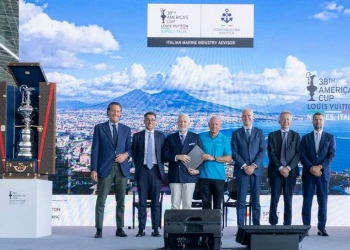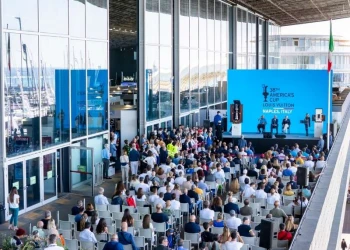
© Adam Mustill / America's Cup
America’s Cup: the LEQ12 in full teenage development mode
The defence of the America’s Cup is very much on with Emirates Team New Zealand taking to the crystal summer waters of the Hauraki Gulf today to line up the One-Design AC40 against its snarling sister, the LEQ12 in full teenage development mode.
What we know for sure about the developments to date is that the port side anhedral foil on the LEQ12 is a significant step forward to the standard AC40 foil but when on the starboard foil, the speed and height differences are minimal. From a design perspective, that’s one big box ticked off and the foil analysts will no doubt continue heavily down the refinement part of the foils unseen on the super-computers whirring away back in Dan Bernasconi’s office. Where the horsepower though will be generated is up aloft and, on the Chase Boat today, most notably, was Burns Fallow checking on what looked like a new headboard arrangement on the LEQ12 that was somewhat of a struggle to get launched.
No fewer than six people were aboard the LEQ12 wrestling with the double skin mainsail arrangement and from the spy shots it very much looks like the head of the sail is being connected to the clew and tack to induce better control at the peak via control lines running down between the twin-skins. Larger, puffier battens were noted just below the yellow-topped headboard where a span of two battens running out to support the flat-top and the initial part of the leech just below were clearly seen. At the very top of the sail, a fold-over cover seals the two skins together but once sailing, it was noticeable that the twin skins were further apart at the head than we’ve seen in recent flights and certainly more pronounced than on the AC40.

Sail-making alchemy is afoot and the genius wizard that is Burns Fallow is once again at his mischievous, innovative mixing cauldron but, as with all experiments, sometimes things just don’t go to plan. As the LEQ12 began its line-up session with the AC40 off Rangitoto, the recon unit recorded that: “a large wrinkle was noticed down the luff of the mainsail on its port skin,” and sailing was halted soon after.
Curly Salthouse, the legendary Kiwi head of on-water operations who is now in his tenth America’s Cup campaign summed up the short afternoon session accurately saying: “We waited for the breeze, sort of a typical sea-breeze day here in Auckland…and left the dock about 2.30pm something like that, unfortunately on one of the boats we've made a little change to the sail configuration, and we’ve done some damage to some battening, something that we couldn't really replace and keep going on the water. So, one boat’s back in early and we’ll lift that out and fix it for tomorrow, that's not a big job, but it's just something we’re trying…and it wasn’t up to the task, we’ll rectify that and go again.”
Emirates Team New Zealand’s mark on the America’s Cup is innovation and the runway from now through to the event starting in Barcelona in September 2024 is going to be littered with new tech, new technique and new hardware coming into what many predict will be the closest Cup in its history. Ranged against the Kiwis are mighty, well-funded data and tech driven challengers who are all poring over the videos and photos captured by the on-water recon teams. Everyone is watching Emirates Team New Zealand like a hawk and the slow trickle of developments being tested and showcased are premium viewing for the armies of analysts watching closely. Today’s footage will be pored over for clues about what the Defenders are up to up top and where they are concentrating to find that click of speed that makes all the difference.
Seven minutes of sailing time doesn’t sound much – it was enough to send the hares racing though. Watching Emirates Team New Zealand is almost a sport in itself. The programme continues tomorrow.






